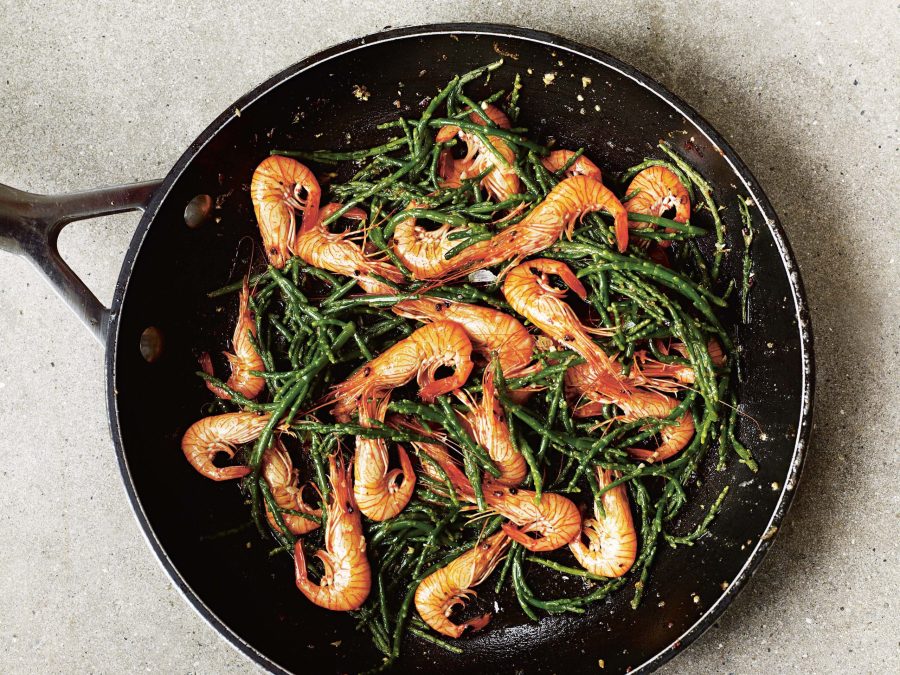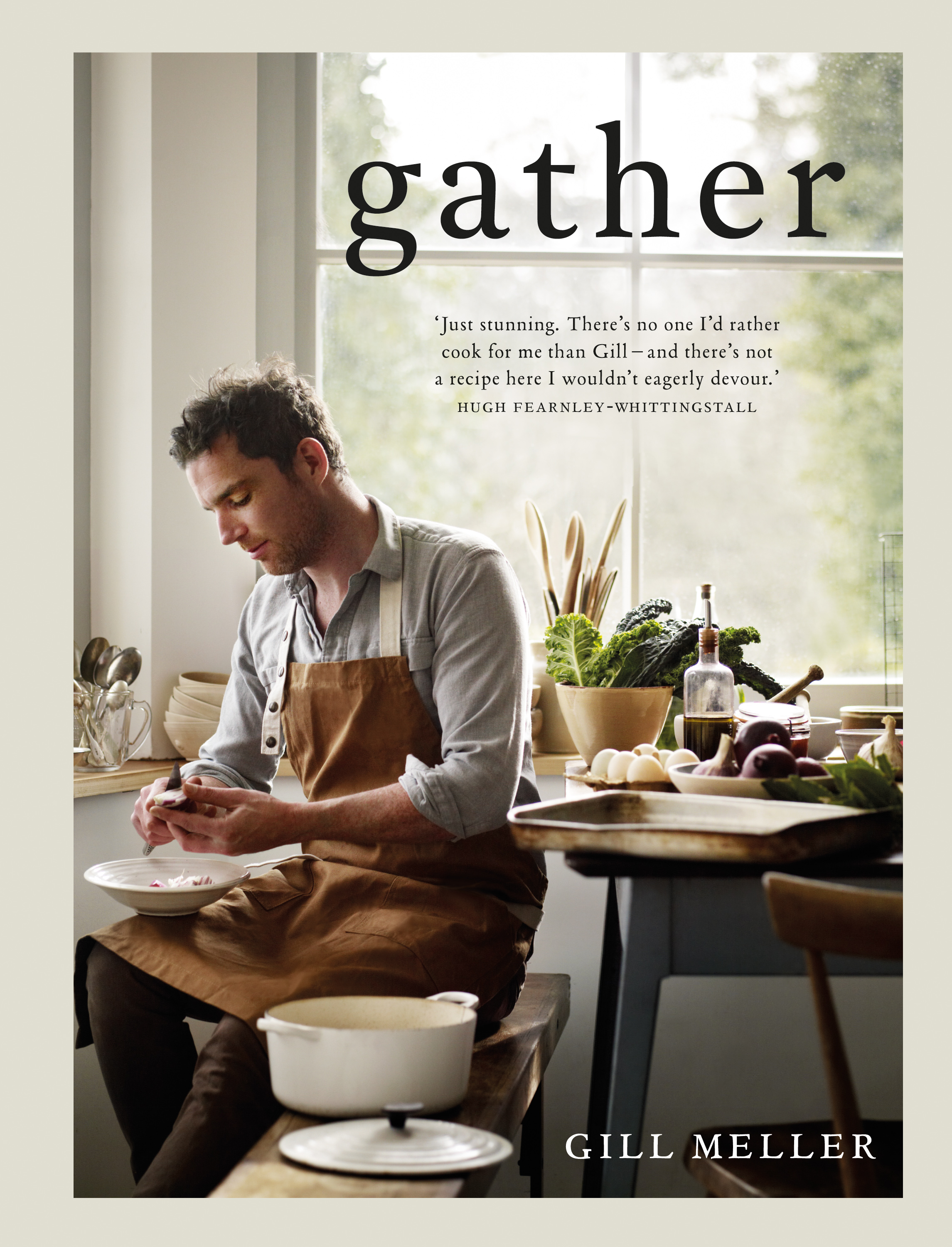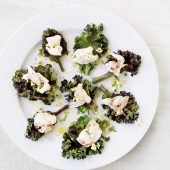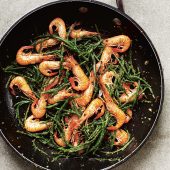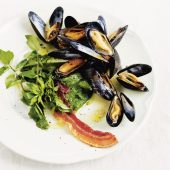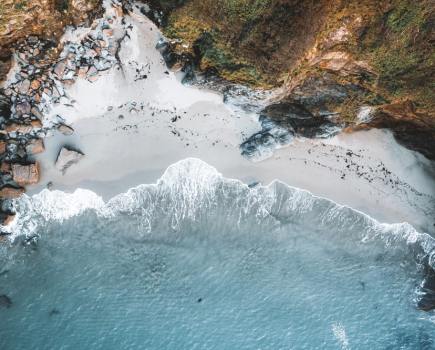River Cottage chef Gill Meller's Gather offers simple and unique recipes, inspired by the landscape in which he lives. Words: Gill Meller. Photographs: Andrew Montgomery
SEA KALE & SEA BASS
Serves 6 as a canapé
Sea kale is a striking and hardy plant that seems to flourish on bleak, inhospitable pebble beaches. Quite often it will be alone, the only copper-green bloom of life bound and rooted expressively to the hard stones. In spring it buds, producing the most delicious broccoli-like spears. The new leaf growth is so tender you can eat it raw, while the slightly larger leaves respond well to blanching or steaming lightly and serving with butter and good olive oil. Both raw and cooked, the leaves have a gentle salinity, as many of our coastal greens do. In late spring and early summer, the plant blooms, producing dainty, edible white flowers. In the autumn it fruits, producing hundreds of pearl-like berries. In the winter, you can find the dead frames of sea kale plants tumbling about the beach in the wind, often with their berries still attached.
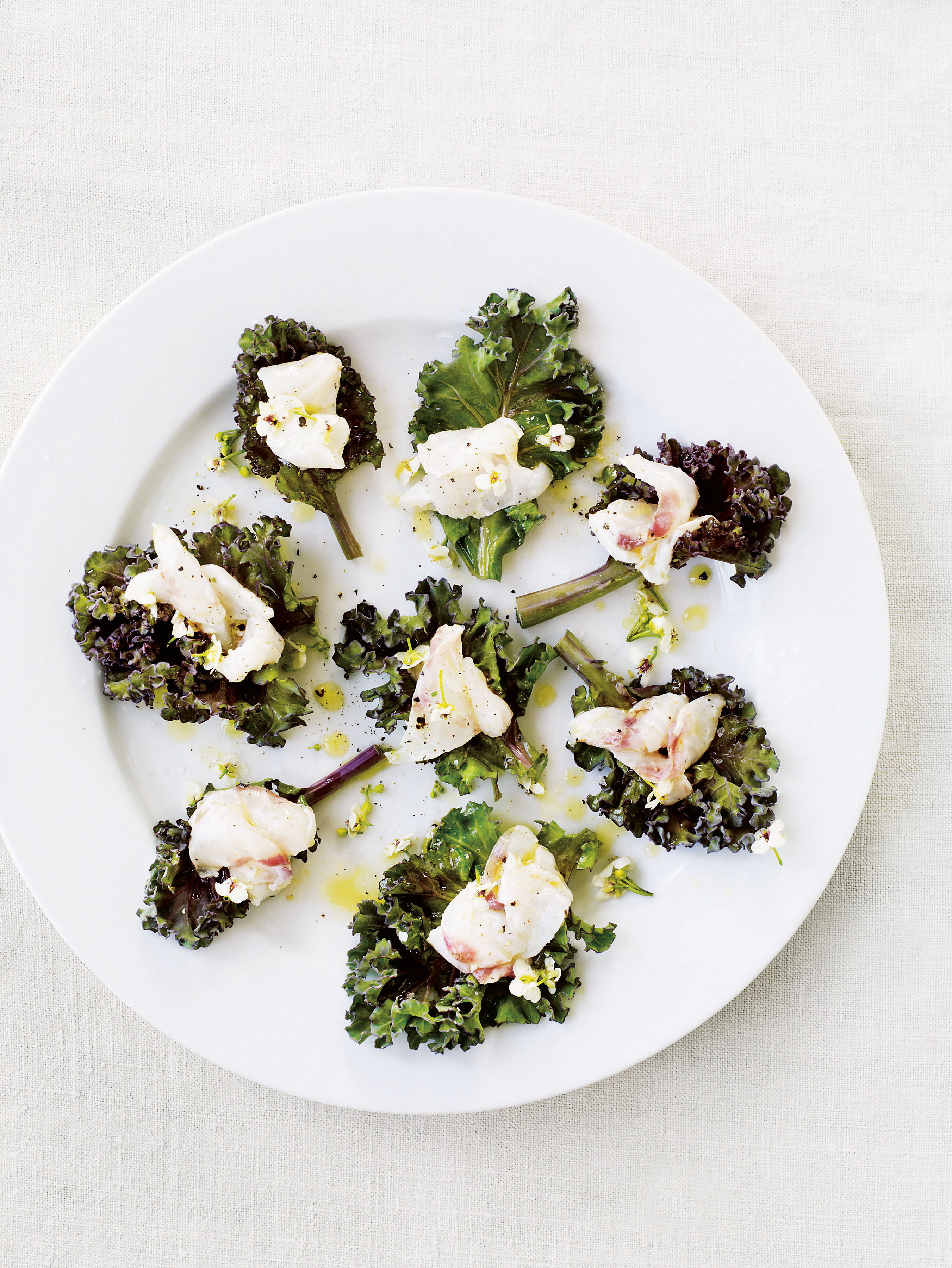
INGREDIENTS:
100g (3 ½ oz) impeccably fresh bass fillet, skinned
Juice of ½ lemon
1 tablespoon extra-virgin olive oil
12 small sea kale or young curly kale leaves
sea kale flowers, if available
salt and freshly ground black pepper
METHOD:
Place the sea-bass fillet on a board and cut it into thin slices, each no more than 5mm (.in) thick, across the grain.
Place the fish slices in a small bowl, then add the lemon juice and olive oil and season well with salt and pepper.
Gently wash the sea kale leaves and arrange them on a serving plate or a board. Spoon a little sea bass onto each leaf along with the oil and lemon from the bowl. Serve scattered with kale flowers, if available.
SAMPHIRE & PRAWNS WITH BUTTER & MACE
Serves 4
A popular wild sea green, samphire comes from the same family as sea beet (see p. 69). You can find it on tidal mud flats, inlets and estuaries, although always take care not to uproot the plant – or to become rooted in the mud yourself! And if time and tide aren’t on your side, this tiny twig of a sea vegetable is also readily available in supermarkets these days. Its fleshy, moist and brackish qualities make samphire a gift for fish; and its peculiar, gnarled form makes it a gift for chefs, too. It’s got class, longevity, and an elegance I really like. When I make this dish at home, I tend to use shrimps and I eat them whole, shell and all. I do this because I can, and because it’s interesting. But, if you use larger prawns you might find the ‘whole shell-on approach’ texturally challenging…
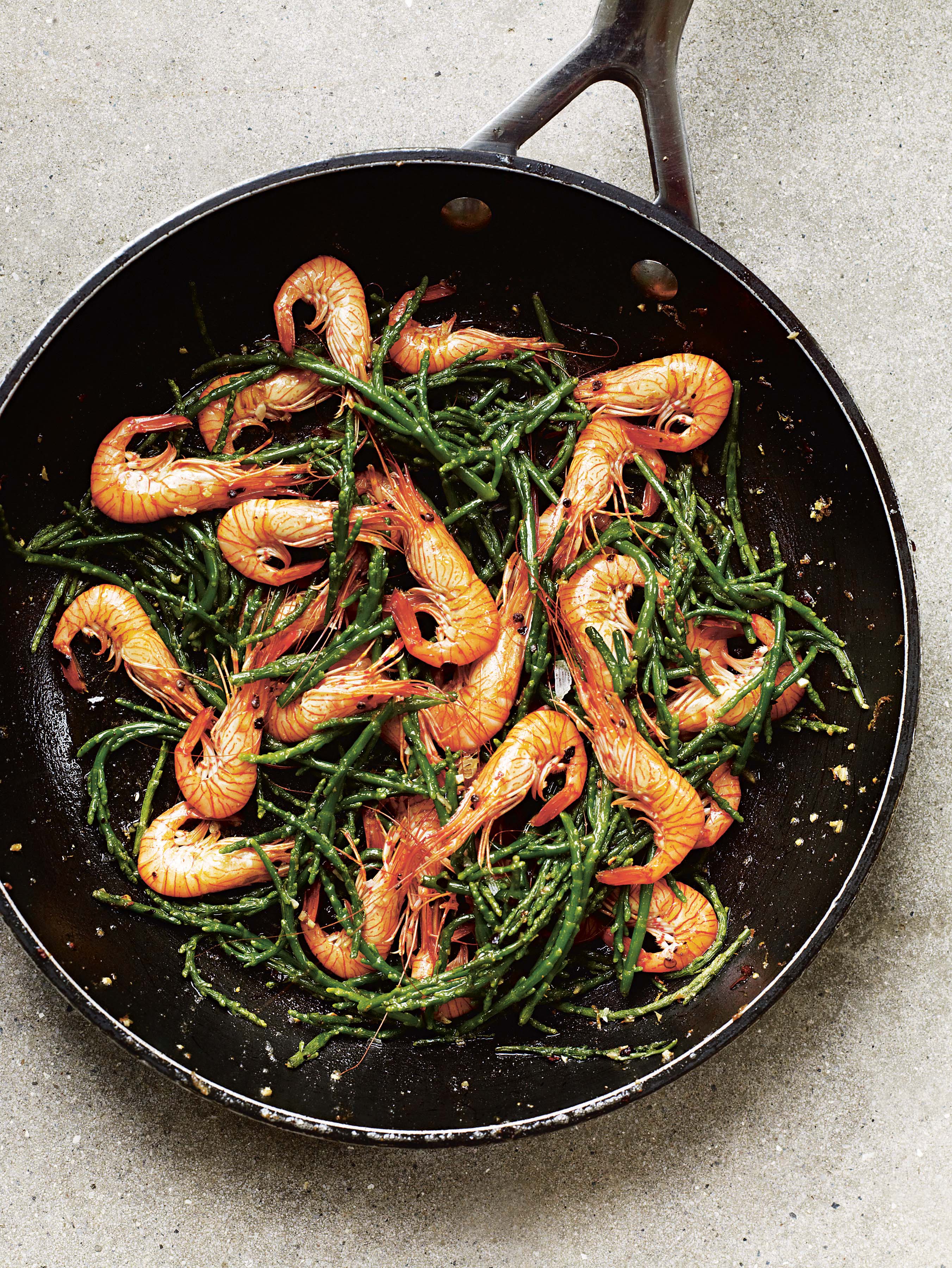
INGREDIENTS:
250g (9oz) marsh samphire, coarser stems trimmed
1 knob of butter
2 tablespoons extra-virgin
Olive oil
2 garlic cloves, peeled and very thinly sliced
½ teaspoon chilli flakes
Zest of ½ lemon and the juice of 1 whole lemon
½ teaspoon ground mace
400g (14oz) shell-on cooked prawns or shrimps or live prawns or shrimps
Salt and freshly ground black pepper
METHOD:
Bring a medium pan of water to the boil. Drop in the samphire and cook for 3–4 minutes, until tender. Drain and set aside.
Heat the butter and olive oil in a large frying pan over a medium heat. When bubbling, add the garlic, chilli flakes, lemon zest and mace. Cook, stirring regularly, for 1–2 minutes, until the garlic is just beginning to colour around the edges.
Add the drained samphire to the pan and toss well.
If you have live prawns or shrimps, blanch them in salted boiling water for a few minutes until they’ve lost their translucency and are cooked through.
Scatter over the cooked shellfish, add the lemon juice, season well with salt and pepper, and remove from the heat as soon as the prawns or shrimps are warm.
Divide the mixture equally onto four plates and serve straight away with good bread and butter.
MUSSELS WITH WATERCRESS, WATERCRESS PUREE & BACON
Serves 2 as a light supper or a lunch
Here are the three things I was thinking about when I invented this dish. First, my favourite soup of all might be watercress, if it were made as I like it: brilliant green, rich and seasoned to the hilt. Second, like many others, I’m massively partial to the salty sweetness of good, crisp streaky bacon. Third, I have a healthy love for freshly cooked mussels, in all their guises. So, this dish is the child of those ideas, those culinary ‘wants’. Conceived and delivered at my kitchen table, its creation was a quiet labour during a morning well spent. As soon as the mussels are cooked, wilt the watercress and make the puree: move fast and serve everything nice and hot.

INGREDIENTS:
Extra-virgin olive oil, for frying 2–4 rashers smoked or unsmoked streaky bacon
1 small knob of butter
½ small onion, sliced
1 garlic clove, peeled and sliced
1kg (2lb 4oz) mussels, cleaned
150g (5 ½ oz) watercress, plus extra for serving
Salt and freshly ground black pepper
METHOD:
Place a medium frying pan over a medium–high heat. Add a dash of oil followed by the bacon. Cook the bacon for 6–8 minutes, until golden and crisp, or to your liking. Keep warm.
Heat a large pan over a medium heat. Add the butter and a spoonful of bacon fat from the frying pan. When the fat mixture is bubbling, add the onion and garlic, and season with a little salt and pepper.
Cook the onion and garlic for 2–3 minutes, until the onion is soft but not coloured, then add the mussels along with 2 tablespoons of water. Place a lid on the pan and give it a gentle shake.
Cook the mussels for 1–2 minutes, or until the mussel shells are all just open. Discard any mussels that haven’t opened up.
Using a slotted spoon, remove the mussels from the pan to a warm, large bowl, leaving the pan (with the onion and cooking liquor) on the heat. Cover the mussels with a clean tea towel and keep as warm as possible.
Throw the watercress into the pan and cook for 1–2 minutes until wilted, then tip the contents of the pan straight into a food processor and puree until smooth.
Place a generous spoonful of puree onto each plate. Divide the mussels equally between the two plates, and finish with a piece of crisp bacon and a little fresh watercress. Serve straight away.
Gather by Gill Meller (Quadrille, £25.00). Photographer: Andrew Montgomery. For more recipes and food and drink stories click here or pick up a copy of the magazine.
River Cottage chef Gill Meller's Gather offers simple and unique recipes, inspired by the landscape in which he lives. Words: Gill Meller. Photographs: Andrew Montgomery
SEA KALE & SEA BASS
Serves 6 as a canapé
Sea kale is a striking and hardy plant that seems to flourish on bleak, inhospitable pebble beaches. Quite often it will be alone, the only copper-green bloom of life bound and rooted expressively to the hard stones. In spring it buds, producing the most delicious broccoli-like spears. The new leaf growth is so tender you can eat it raw, while the slightly larger leaves respond well to blanching or steaming lightly and serving with butter and good olive oil. Both raw and cooked, the leaves have a gentle salinity, as many of our coastal greens do. In late spring and early summer, the plant blooms, producing dainty, edible white flowers. In the autumn it fruits, producing hundreds of pearl-like berries. In the winter, you can find the dead frames of sea kale plants tumbling about the beach in the wind, often with their berries still attached.

INGREDIENTS:
100g (3 ½ oz) impeccably fresh bass fillet, skinned
Juice of ½ lemon
1 tablespoon extra-virgin olive oil
12 small sea kale or young curly kale leaves
sea kale flowers, if available
salt and freshly ground black pepper
METHOD:
Place the sea-bass fillet on a board and cut it into thin slices, each no more than 5mm (.in) thick, across the grain.
Place the fish slices in a small bowl, then add the lemon juice and olive oil and season well with salt and pepper.
Gently wash the sea kale leaves and arrange them on a serving plate or a board. Spoon a little sea bass onto each leaf along with the oil and lemon from the bowl. Serve scattered with kale flowers, if available.
SAMPHIRE & PRAWNS WITH BUTTER & MACE
Serves 4
A popular wild sea green, samphire comes from the same family as sea beet (see p. 69). You can find it on tidal mud flats, inlets and estuaries, although always take care not to uproot the plant – or to become rooted in the mud yourself! And if time and tide aren’t on your side, this tiny twig of a sea vegetable is also readily available in supermarkets these days. Its fleshy, moist and brackish qualities make samphire a gift for fish; and its peculiar, gnarled form makes it a gift for chefs, too. It’s got class, longevity, and an elegance I really like. When I make this dish at home, I tend to use shrimps and I eat them whole, shell and all. I do this because I can, and because it’s interesting. But, if you use larger prawns you might find the ‘whole shell-on approach’ texturally challenging…

INGREDIENTS:
250g (9oz) marsh samphire, coarser stems trimmed
1 knob of butter
2 tablespoons extra-virgin
Olive oil
2 garlic cloves, peeled and very thinly sliced
½ teaspoon chilli flakes
Zest of ½ lemon and the juice of 1 whole lemon
½ teaspoon ground mace
400g (14oz) shell-on cooked prawns or shrimps or live prawns or shrimps
Salt and freshly ground black pepper
METHOD:
Bring a medium pan of water to the boil. Drop in the samphire and cook for 3–4 minutes, until tender. Drain and set aside.
Heat the butter and olive oil in a large frying pan over a medium heat. When bubbling, add the garlic, chilli flakes, lemon zest and mace. Cook, stirring regularly, for 1–2 minutes, until the garlic is just beginning to colour around the edges.
Add the drained samphire to the pan and toss well.
If you have live prawns or shrimps, blanch them in salted boiling water for a few minutes until they’ve lost their translucency and are cooked through.
Scatter over the cooked shellfish, add the lemon juice, season well with salt and pepper, and remove from the heat as soon as the prawns or shrimps are warm.
Divide the mixture equally onto four plates and serve straight away with good bread and butter.
MUSSELS WITH WATERCRESS, WATERCRESS PUREE & BACON
Serves 2 as a light supper or a lunch
Here are the three things I was thinking about when I invented this dish. First, my favourite soup of all might be watercress, if it were made as I like it: brilliant green, rich and seasoned to the hilt. Second, like many others, I’m massively partial to the salty sweetness of good, crisp streaky bacon. Third, I have a healthy love for freshly cooked mussels, in all their guises. So, this dish is the child of those ideas, those culinary ‘wants’. Conceived and delivered at my kitchen table, its creation was a quiet labour during a morning well spent. As soon as the mussels are cooked, wilt the watercress and make the puree: move fast and serve everything nice and hot.
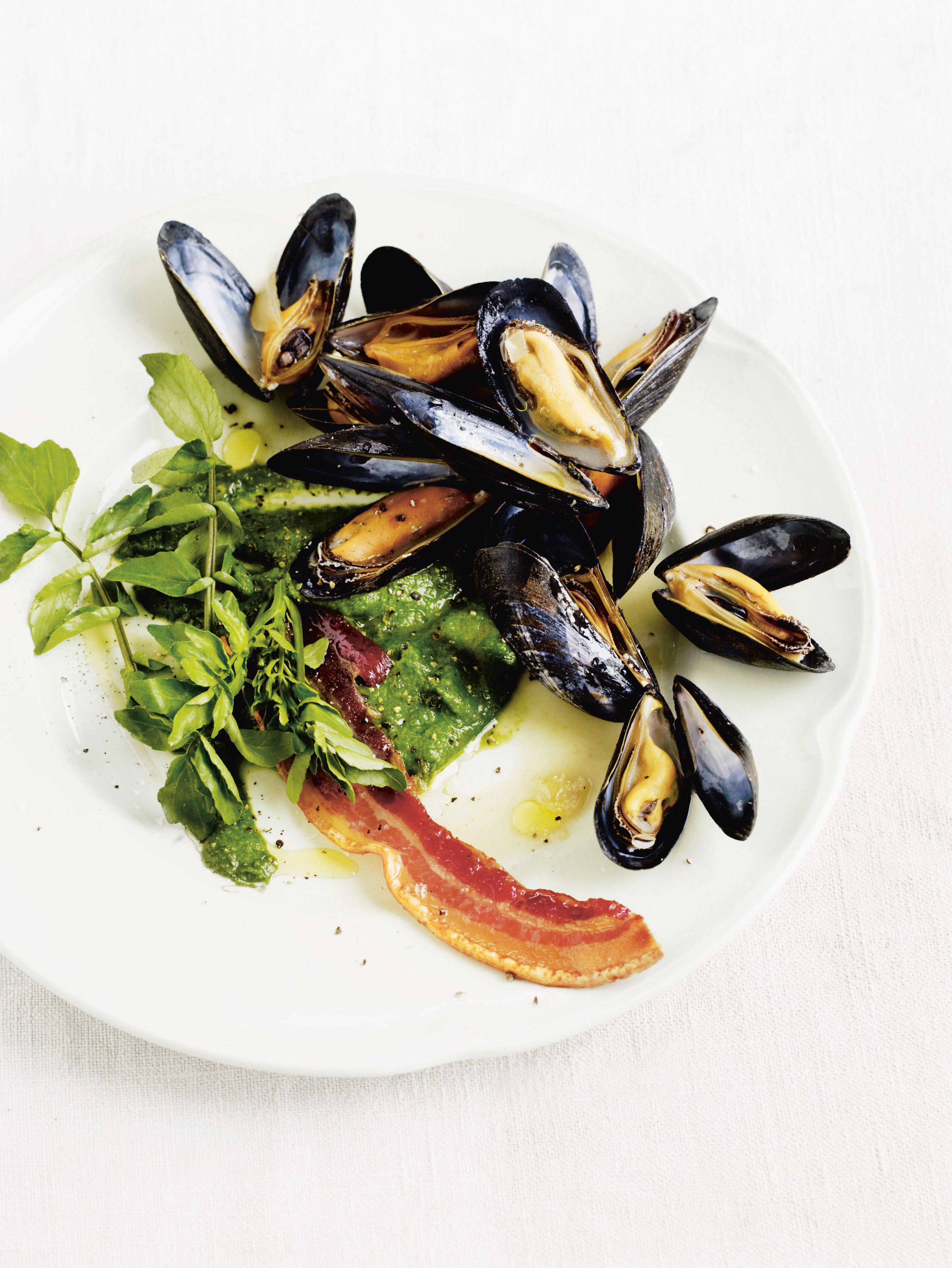
INGREDIENTS:
Extra-virgin olive oil, for frying 2–4 rashers smoked or unsmoked streaky bacon
1 small knob of butter
½ small onion, sliced
1 garlic clove, peeled and sliced
1kg (2lb 4oz) mussels, cleaned
150g (5 ½ oz) watercress, plus extra for serving
Salt and freshly ground black pepper
METHOD:
Place a medium frying pan over a medium–high heat. Add a dash of oil followed by the bacon. Cook the bacon for 6–8 minutes, until golden and crisp, or to your liking. Keep warm.
Heat a large pan over a medium heat. Add the butter and a spoonful of bacon fat from the frying pan. When the fat mixture is bubbling, add the onion and garlic, and season with a little salt and pepper.
Cook the onion and garlic for 2–3 minutes, until the onion is soft but not coloured, then add the mussels along with 2 tablespoons of water. Place a lid on the pan and give it a gentle shake.
Cook the mussels for 1–2 minutes, or until the mussel shells are all just open. Discard any mussels that haven’t opened up.
Using a slotted spoon, remove the mussels from the pan to a warm, large bowl, leaving the pan (with the onion and cooking liquor) on the heat. Cover the mussels with a clean tea towel and keep as warm as possible.
Throw the watercress into the pan and cook for 1–2 minutes until wilted, then tip the contents of the pan straight into a food processor and puree until smooth.
Place a generous spoonful of puree onto each plate. Divide the mussels equally between the two plates, and finish with a piece of crisp bacon and a little fresh watercress. Serve straight away.
Gather by Gill Meller (Quadrille, £25.00). Photographer: Andrew Montgomery. For more recipes and food and drink stories click here or pick up a copy of the magazine.

